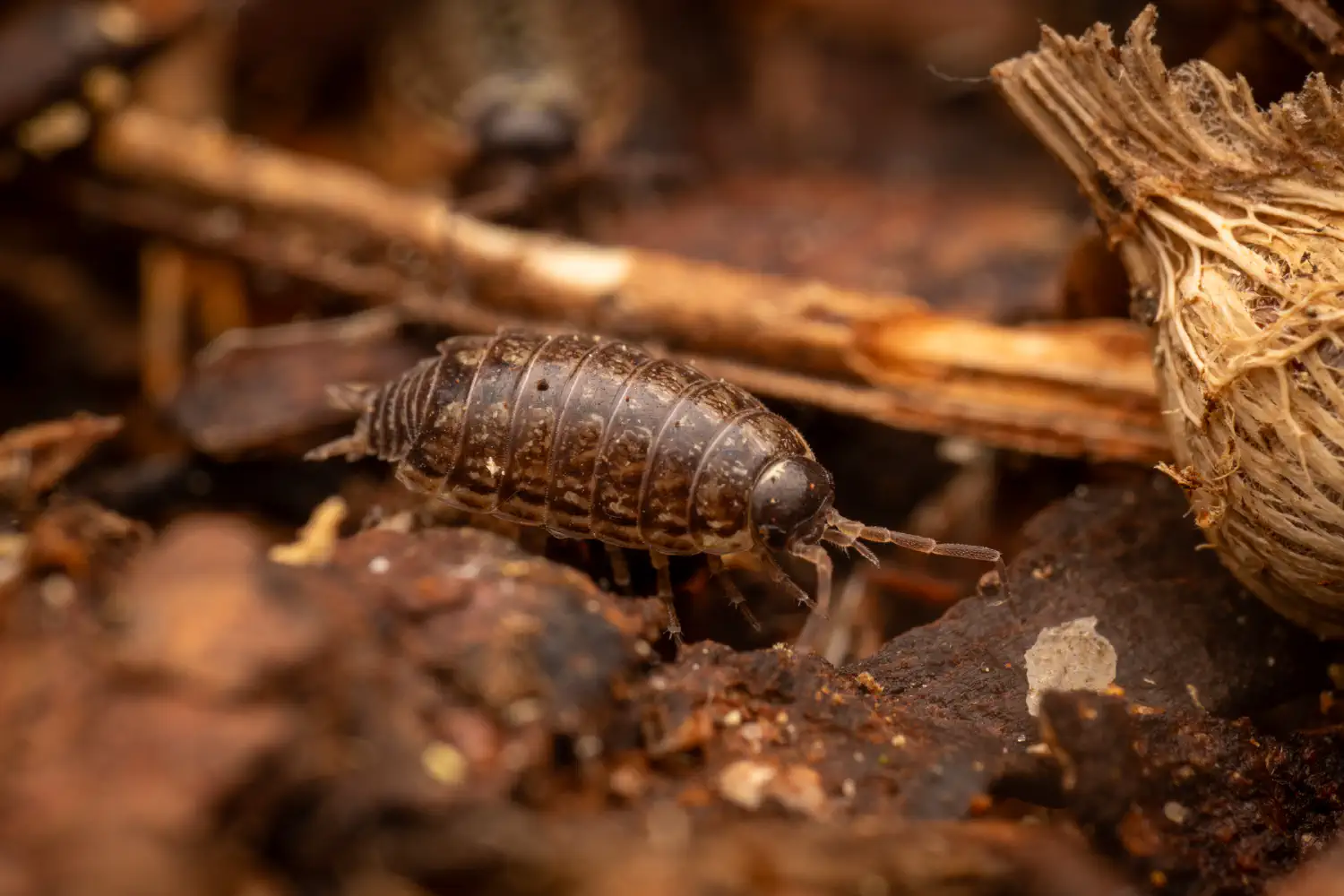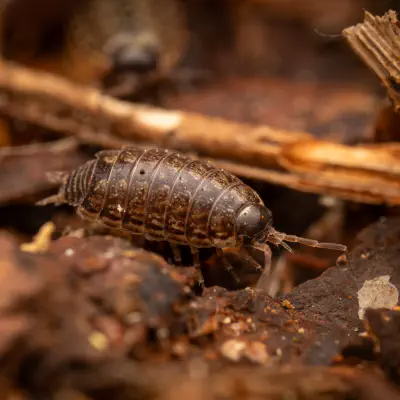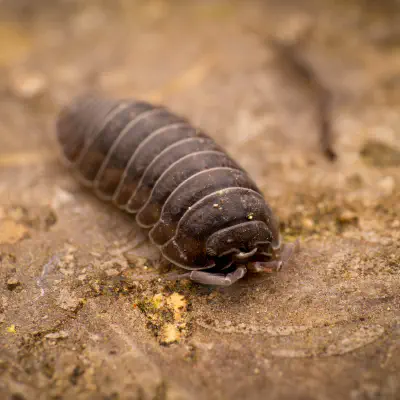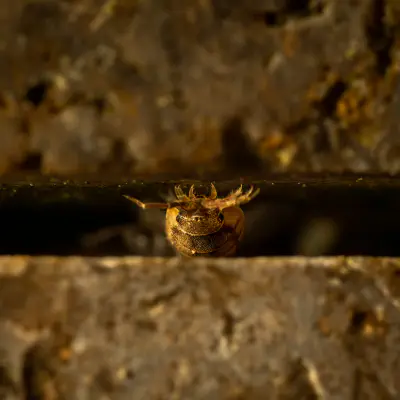Woodlice, Pillbugs, and Rock Slaters Lat. “Oniscidea“
A woodlouse (plural woodlice) is a terrestrial isopod crustacean with a rigid, segmented, long exoskeleton and fourteen jointed limbs. Woodlice mostly feed on dead plant material, and they are usually active at night. Woodlice form the suborder Oniscidea within the order Isopoda, with over 5,000 known species.
Hierarchy
Common names
Common names for woodlice vary throughout the English-speaking world. A number of common names make reference to the fact that some species of woodlice can roll up into a ball. Other names compare the woodlouse to a pig. The collective noun is reported to be a quabble (of woodlice), but the origins of this are unknown. Common names include:
Description and life cycle
The woodlouse has a shell-like exoskeleton, which it must progressively shed as it grows. The moult takes place in two stages; the back half is lost first, followed two or three days later by the front. This method of moulting is different from that of most arthropods, which shed their cuticle in a single process. It is theorized that this allows woodlice to maintain partial mobility while molting. A female woodlouse will keep fertilised eggs in a marsupium on the underside of her body, which covers the under surface of the thorax and is formed by overlapping plates attached to the bases of the first five pairs of legs. They hatch into offspring that look like small white woodlice curled up in balls, although initially without the last pair of legs. The mother then appears to “give birth” to her offspring. A few species are also capable of reproducing asexually. Despite being crustaceans like lobsters or crabs, woodlice are said to have an unpleasant taste similar to “strong urine”. This is due to their high concentration of uric acid, which is one of the chemicals in urine. Their flavor has also been compared to shellfish.
Pillbugs and pill millipedes
Pill bugs (woodlice of the family Armadillidiidae and Armadillidae) can be confused with pill millipedes of the order Glomerida. Both of these groups of terrestrial segmented arthropods are about the same size. They live in very similar habitats, share a similar diet, and conglobate as a defense mechanism. Pill millipedes and pillbugs appear superficially similar to the naked eye. This is an example of convergent evolution.
These two groups can be distinguished in several ways. Glomeris millipedes have 19 (males) or 17 (females) pairs of legs as adults, while adult pill bugs only have 7 pairs of legs. Additionally, pill bugs have a thorax consisting of 7 body segments, 5 abdominal segments, and a pleotelson, while Glomeris millipedes lack a visually defined thorax and have 12 body segments total. While the uropods of pillbugs are relatively quite small, flipping a pill bug over will reveal the small uropod overlapping the pleotelson. Some woodlouse species, like Armadillidium maculatum, seem to display Batesian Mimicry to certain pill millipedes like Glomeris marginata.
Ecology
Many members of Oniscidea live in terrestrial, non-aquatic environments, breathing through trachea-like lungs in their paddle-shaped hind legs (pleopods), called pleopodal lungs. Woodlice need moisture because they rapidly lose water by excretion and through their cuticle, and so are usually found in damp, dark places, such as under rocks and logs, although one species, the desert-dwelling Hemilepistus reaumuri, inhabits “the driest habitat conquered by any species of crustacean”. They are usually nocturnal and are detritivores, feeding mostly on dead plant matter. A few woodlice have returned to water. Evolutionary ancient species are amphibious, such as the marine-intertidal sea slater (Ligia oceanica), which belongs to family Ligiidae. Other examples include some Haloniscus species from Australia (family Scyphacidae), and in the northern hemisphere several species of Trichoniscidae and Thailandoniscus annae (family Styloniscidae). Species for which aquatic life is assumed include Typhlotricholigoides aquaticus (Mexico) and Cantabroniscus primitivus (Spain).
Woodlice are eaten by a wide range of insectivores, including spiders of the genus Dysdera, such as the woodlouse spider Dysdera crocata, and land planarians of the genus Luteostriata, such as Luteostriata abundans. Woodlice are sensitive to agricultural pesticides, but can tolerate some toxic heavy metals, which they accumulate in the hepatopancreas. Thus they can be used as bioindicators of heavy metal pollution.
Evolutionary history
The oldest fossils of woodlice are known from the mid-Cretaceous around 100 million years ago, from amber deposits found in Spain, France and Myanmar, These include a specimen of living genus Ligia from the Charentese amber of France, the genus Myanmariscus from the Burmese amber of Myanmar, which belongs to the Synocheta and likely the Styloniscidae, Eoligiiscus tarraconensis which belongs to the family Ligiidae, Autrigoniscus resinicola which belongs to the family Trichoniscidae, and Heraclitus helenae which possibly belongs to Detonidae all from Spanish amber, and indeterminate specimens Charentese amber. The widespread distribution and diversification apparent of woodlice in the mid-Cretaceous implies that the origin of woodlice predates the breakup of Pangaea, likely during the Carboniferous.
As pests
Although woodlice, like earthworms, are generally considered beneficial in gardens for their role in controlling certain pests, producing compost and overturning the soil, some species like those of the genus Armadillidium have also been known to feed on cultivated plants, such as ripening strawberries and tender seedlings. Woodlice can also invade homes in groups searching for moisture, and their presence can indicate dampness problems. They are not generally regarded as a serious household pest as they do not spread disease and do not damage sound wood or structures. They can be easily removed with the help of vacuum cleaners, chemical sprays, insect repellents, and insect killers, or by removing the dampness.
As pets
Woodlice have become a popular household pet for children as well as a hobby for invertebrate and insect enthusiasts or collectors. Porcellionidae (sowbugs) and Armadillididae (pillbugs) are seen often as they are the most common terrestrial isopods in Europe and North America. While some isopod species are kept purely as pets, some can also be used as an addition to bioactive terrariums, due to their ability to break down decaying organic materials.
Classification
There is general agreement that there are five main lineages in suborder Oniscidea, although the phylogenetic relationships between them are unsettled. Two main schemes for the classification that differ in which group is considered sister to the remaining oniscideans. One places Ligiidae in section Diplocheta, with the remaining families divided between four sections in infraorder Holoverticata. The other places Tylidae in infraorder Tylomorpha, with the remaining families placed in three sections in infraorder Ligiamorpha. The former scheme is presented below.
Section: Crinocheta
Beyond these, some genera are of uncertain familial assignment such as:
Exalloniscus Sunniva etc.
See also
Invertebrate iridescent virus 31 – a species of virus hosted by woodlice
Further reading
Helmut Schmalfuss (2003). “World catalog of terrestrial isopods (Isopoda: Oniscidea)—revised and updated version” (PDF). Stuttgarter Beiträge zur Naturkunde, Serie A. 654: 341 pp. Archived from the original (PDF) on February 24, 2009. Retrieved July 30, 2018. (lists all validated species of Oniscidea published up to the end of 2004) Helmut Schmalfuss; Karin Wolf-Schwenninger (2002). “A bibliography of terrestrial isopods (Crustacea, Isopoda, Oniscidea)—revised and updated version” (PDF). Stuttgarter Beiträge zur Naturkunde, Serie A. 639: 120 pp. Archived from the original (PDF) on September 25, 2015. Retrieved July 30, 2018. (lists most scientific publications on the biology of Oniscidea published in a European language until the year 2004.) Christian Schmidt & Andreas Leistikow (2004). “Catalogue of the terrestrial Isopoda (Crustacea: Isopoda: Oniscidea)” (PDF). Steenstrupia. 28 (1): 1–118. (lists all genera published up to the end of 2001)
External links
Media related to Oniscidea at Wikimedia Commons Data related to Oniscidea at Wikispecies
Ancestry Graph
Further Information
„Woodlice, Pillbugs, and Rock Slaters“ on wikipedia.org
„Woodlice, Pillbugs, and Rock Slaters“ on iNaturalist.org
Copyright

This article uses material from the Wikipedia article Oniscidea the free encyclopedia Wikipedia which is released under Creative Commons Attribution-ShareAlike 4.0 International License). On Wikipedia a list of authors is available.

Little beings in print
Order our calendars and books today!
Compiled with love. Printed sustainably. Experience our little beings even more vividly in print. All our publications are available for a small donation.




